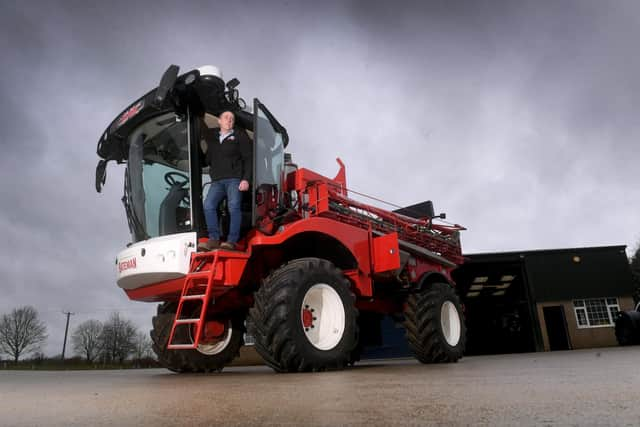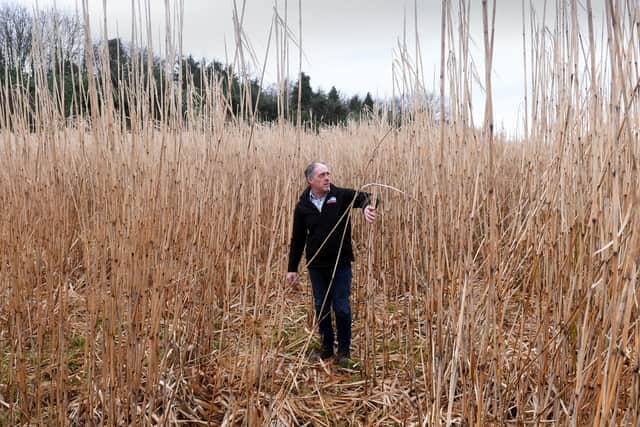Farm of the Week: From tractor driving to managing Lightwater Valley theme park owner's farm
Jonathan says that getting to grips with something other than a steering wheel for the first time in his working life had been a total game changer, invigorating and a little bit scary.
“I don’t think I slept much that first year,” says Jonathan. “I’d had no management experience, no prior responsibilities other than driving a tractor and because the farm had previously been run under a share farming agreement we had the land but we had no farm machinery of our own. I had to go out and purchase it all and set the farm up.
Advertisement
Hide AdAdvertisement
Hide AdJonathan had been instructed to come up with a plan for the farm to the Lightwater Group, that includes several other businesses including quarrying and a concrete business, commercial shoot and accommodation, all owned by the Staveley family who now contract out their Lightwater Valley adventure park to a leisure group.


Jonathan says that in the course of his deliberations one of his areas of focus became ploughing.
“I put a presentation to the board saying we had been ploughing 1000 acres every year, moving two million tonnes of soil per year and asked whether that would be considered major if the quarry moved that much.
“I became more fully aware of the regenerative approach of strip till and direct drilling having since joined BASE UK, the fount of all knowledge for direct drilling, but it was the cost saving we could make in moving away from the plough that tipped it with the board.
Advertisement
Hide AdAdvertisement
Hide Ad“We started with strip till drilling and moved on to direct drilling as each field was ready for it and we no longer plough at all. We tried it in a small way five years ago, ploughing in front of some naked oats as we were trying to get rid of brome. We ended up getting more brome in the ones we ploughed than the ones we didn’t.


More recently the farm went into Monitor Farm status with AHDB, which brings farms and other farming experts together to talk and benchmark.
Lightwater is coming to the end of a three-year term as such and Jonathan says it has been a fantastic experience.
“Prior to becoming a monitor farm I’d attended an AHDB meeting at York where I’d talked with progressive farmer David Blacker who’d said that it would be brilliant for me and another had said how much his knowledge and confidence had developed.
Advertisement
Hide AdAdvertisement
Hide Ad“Getting other farmers and farm experts on to the farm and that whole conversation you have has been just brilliant. It has definitely upped my confidence, assured me that I’m on the right track and has given me fresh ideas. It gives you that impetus to try things on your farm and that confidence to stand up in front of your peers and explain what you’ve done, like trials you’ve held.
“It has certainly helped with our farming business here. You’re speaking with people who’ve done it before and who might have made the same mistakes you have.
“You don’t stand up in front of fellow farmers and talk ‘pub yields’, you tell them the absolute truth. If you’ve made a mess you tell them you’ve made a mess and you’re guaranteed at least one person will come up to you afterwards and say, ‘I’ve done that and next time you should do this’. That whole exchange between farmers is what it’s all about.
“We have our final meeting as a monitor farm in June, but we’ve just had an organic farmer John Pawsey come up from Cambridge because we are looking at what we and other farmers can we learn from organic farming. It’s not about what we are doing wrong, but whether we can bring anything from the way an organic farmer works into our regenerative system.
Advertisement
Hide AdAdvertisement
Hide AdLightwater’s acreage includes land at North Stainley, Thornborough Henges and a farm business tenancy at Snape. The arable acreage includes 400 acres of winter wheat, currently growing Champion, Dawsum and Insitor varieties, 100 acres each of winter beans, naked oats, winter barley, growing the Kingsbarn variety, oilseed rape and spring beans.
“We are on mainly sandy loam and stick largely to producing crops going into animal feeds due to the uncertainty of hitting the higher grades and the costs associated of such as biscuit and bread wheats and the transport costs to the mills, but also because we have a lot of feed mills in the area and often find we get more of a premium by growing feed wheats. You grow to your markets. Ours go to I’Anson’s in Masham just six miles up the road.
Getting farm drainage right, avoiding insect damage to crops and dealing with brome are just some of Jonathan’s concerns. He’s bought a trencher to help with drainage.
“Some of our land next to the river is the worst draining we have. We’ve either been lucky or we are doing something just a little bit different in avoiding flea beetle in our oilseed rape. We direct drill into a stubble and put farmyard manure on. We avoided flea beetle flight this past year once again. We are monitoring the winter and spring beans this year so we can see what gives best brome control and also looking at bruchid beetle control.
Advertisement
Hide AdAdvertisement
Hide AdJonathan says he’s getting a little more confident with forward selling of grain and that the farm’s grain stores have been renewed.
“The first year or two I was scared about selling something forward that was then only two inches tall, but I’ve now sold forward for January 2025 at a price I’m happy with compared to the current wheat price.
“What happened in the Ukraine gave us arable farmers a triple whammy in fertiliser, fuel and farm machinery prices, but for us it was a quadruple as we decided to renew the grain stores and lost out on the increased grain price as we had to sell before Christmas to get the grain stores empty so we could pull them down to get new ones up ready for harvest. We missed out on getting higher prices and got all the higher costs.
The rest of the 1800 acres includes 250 acres of woodland, 200 acres of grassland and 25 acres of willow and 40 acres of miscanthus, both of the final two having gone in initially about eight years ago.
Advertisement
Hide AdAdvertisement
Hide Ad“Miscanthus goes into a straw burning power station at Brigg,” says Jonathan. “The willow
goes to a local woodchipper.
Jonathan has learned a great deal since being handed the farm manager’s position. He’s looking at the new SFI schemes but admits to being perplexed as to why it seems he can’t go into the main scheme at present, and while he is keen on regenerative farming principles and sustainability, he has his own definition of the latter.
“Sustainable to me means profitable working with the environment, with the soil, but at the end of the day we’ve got to be profitable.
Comment Guidelines
National World encourages reader discussion on our stories. User feedback, insights and back-and-forth exchanges add a rich layer of context to reporting. Please review our Community Guidelines before commenting.